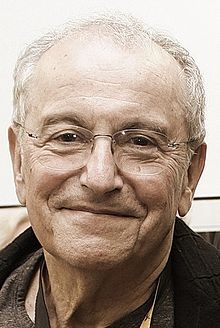Ryszard Horowitz
Ryszard Horowitz | |
|---|---|
 Ryszard Horowitz (2014) | |
| Born | May 5, 1939 Kraków, Poland |
| Nationality | Polish, American |
| Known for | Photography |
| Style | Surrealism, |
| Spouse(s) | Anna Bogusz (m. 1974) |
| Children | 2 |
| Website | www |
Ryszard Horowitz (born May 5, 1939) is a Polish-born American photographer. He is recognized as a pioneer of special effects photography that predates digital imaging.[1]
Early life[]
Horowitz was born in Kraków, Poland on May 5, 1939. Four months later, Ryszard's entire family were forced into concentration camps following the German invasion of Poland.[1][2] From September 1944 he was imprisoned at Auschwitz and later became known as being among the youngest known people to survive Auschwitz concentration camp and to be listed on Schindler's list. At the war's end, five-year old Ryszard was reunited with his family after his mother found him in an orphanage,[3] and they were amongst the few Jewish families to re-establish themselves in Krakow.[4][5][6][7][8]
Horowitz began taking pictures at the age of fourteen. For a brief period of time during his childhood he grew up alongside Roman Polański with whom he created his first photographic enlarger from cardboard.[9]
Career[]
In 1956, the Polish government began awarding subsidies to encourage new and original art forms and Kraków suddenly emerged as a center of avant-garde jazz, painting, theater and filmmaking. For two years, beginning in 1959, Ryszard studied art at the High School of Fine Arts in Kraków and then went on to major in painting at the Academy of Fine Arts. It was at this time that he became interested in photography, particularly the work of American photographers.[2]
Jazz music was of particular interest to Horowitz as a photography student. He photo documented the birth of Polish Jazz[9] and in 1958 photographed jazz legends such as Dave Brubeck, Louis Armstrong, Count Basie, Duke Ellington, and Sonny Rollins at the Newport Jazz Festival.[10]
Ryszard immigrated to the United States in 1959 and enrolled at New York's Pratt Institute in the commercial and advertising graphic design department. Here he encountered his mentors, Richard Avedon and Alexey Brodovitch. Horowitz took part in weekly seminars led by Brodovitch and worked as an assistant for Avedon in 1963, including at his famous portrait session with Salvador Dali. After graduating from Pratt in 1962, Horowitz began working in film and television and graphic design companies, including a stint as Art Director for Grey Advertising.[1][2][9]
In 1967, he opened his own photography studio in New York City. He has developed a successful career in both fine art and commercial photography, but is most well known for creating complex photographic composites, which have been compared to the surrealist artworks of Magritte and Dali. Early in his career, to obtain such effects he used a multitude of photographic techniques such as darkroom retouching, multiple film exposures and manipulation of his camera.[1][9]
In popular culture[]
Horowitz was depicted as a child in Steven Spielberg's epic drama Schindler's List - a film about Oskar Schindler, a German businessman who saved the lives over thousand Polish-Jewish refugees during the Holocaust.[11][12] Horowitz, along with other Schindlerjuden, appears in the final scene as mourners at Schindler's grave in Jerusalem.[13]
Horowitz's photographs appear on the cover of both Dot Hacker's 2014 How's Your Process albums.[14] Because of his unique style he was asked to produce the cover for the premier issue of Nuestro magazine in 1977.
Personal life[]
In 1974, Horowitz married Anna Bogusz, an architect. They have two sons, Daniel and Emil.[15]
References[]
- ^ Jump up to: a b c d "Ryszard Horowitz Photocomposer". Rochester Institute of Technology. Retrieved 26 May 2016.
- ^ Jump up to: a b c "Biography". Retrieved 26 May 2016.
- ^ "Ryszard Horowitz : Descendants of Light, American Photographers of Jewish Ancestry by Penny Wolin". L'oeil de la Photographie. 18 March 2016. Retrieved 26 May 2016.
- ^ Martin, Douglas. "When Holocaust Lives With Parents", The New York Times, April 29, 1995. Accessed February 2, 2009.
- ^ David Margolick (13 February 1994). "Schindler's Jews Find Deliverance Again". The New York Times. Retrieved 26 May 2016.
- ^ Farber, Robert. "Interview with Ryszard Horowitz". Retrieved 26 May 2016.
- ^ "Photographer Horowitz honorary citizen of Krakow". Radio Poland. 30 April 2014. Retrieved 26 May 2016.
- ^ Lyman, Rick (23 January 2015). "For Auschwitz Museum, a Time of Great Change". The New York Times. Retrieved 26 May 2016.
- ^ Jump up to: a b c d "Ryszard Horowitz – Biography". Culture.pl. Retrieved 26 May 2016.
- ^ Felten, Eric (6 February 2014). "Ryszard Horowitz Photographs 'All That Jazz'". Voice of America. Retrieved 26 May 2016.
- ^ Titze, Anne-Katrin. "Generation War in conflict". Eye For Film. Retrieved 26 May 2016.
- ^ "Life after Schindler's List". Parade Magazine. Ocala Star-Banner. 23 February 1997. p. 8. Retrieved 26 May 2016.
- ^ "Ryszard Horowitz Biography". IMDB. Retrieved 26 May 2016.
- ^ "Dot Hacker announces second of two part album release". Hellhound Music. 20 August 2014. Retrieved 26 May 2016.
- ^ John Paul Caponigro (August 2000). "Ryszard Horowitz (9/00)". Retrieved 26 May 2016.
External links[]
- 1939 births
- Photographers from Kraków
- Ashkenazi Jews
- Auschwitz concentration camp survivors
- Gross-Rosen concentration camp survivors
- Jewish American artists
- Kraków Ghetto inmates
- Kraków-Płaszów concentration camp survivors
- Living people
- Photographers from New York City
- Polish emigrants to the United States
- Polish photographers
- Pratt Institute alumni
- Officers of the Order of Merit of the Republic of Poland
- Recipients of the Gold Medal for Merit to Culture – Gloria Artis
- Schindlerjuden
- People with acquired American citizenship